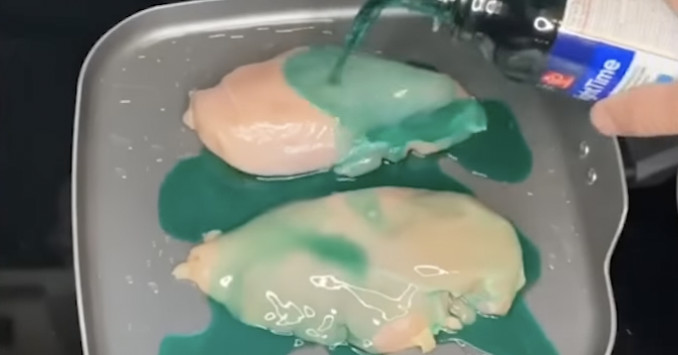
Last week, the Food and Drug Administration issued a warning: Don’t cook your chicken in NyQuil. This needed to be said, according to the FDA, because of a “recent social media video challenge,” presumably linked to TikTok.
The sheer absurdity of this announcement — of course you shouldn’t cook your chicken in NyQuil, much less eat it — shot the story into headlines this week, with TMZ calling “sleepy chicken” the “latest craze” among TikTokers and national news sites following suit to warn against the dangerous trend. Per the FDA, the risk lies primarily in boiling medication, which concentrates it and creates vapor: “Someone could take a dangerously high amount of the cough and cold medicine without even realizing it.”
But here’s the thing: Before all of these reports made NyQuil chicken mainstream, was this “food challenge” actually a trend — are teens, emboldened by TikTok, raiding CVS to boil chicken breast and cough medicine? Or is this, like eating Tide Pods, more likely another meme manufactured into an ouroboros of outrage?
The cyclical nature of NyQuil chicken outrage would suggest the latter. The internet archive of Know Your Meme dates NyQuil chicken to April 1, 2017 (there’s your first red flag), when it was posted on the anonymous forum, 4chan (another red flag, given the platform’s tendency toward trolling and shock content). On 4chan, NyQuil chicken became a kind of “legendary moment” 4chan, Ryan Broderick explains in the newsletter Garbage Day. The concept and the photos occasionally circulate on other platforms, not as actual cooking inspiration but more as the kind of gross-out food meme fodder popularized by accounts like @fuckedupfoods and @boyswhocancook. Sometimes, like now, NyQuil chicken breaks out of these bounds of understanding that some food online exists purely as a shitpost. The same cycle happened this past January: A NyQuil chicken video on TikTok got enough traction to prompt warnings from news publications.
Try to find NyQuil chicken videos, and most of what comes up are reaction clips responding to the same now-deleted video. While it’s possible that TikTok is taking these videos down (the “NyQuil chicken” and “sleepy chicken” search terms currently bring up a safety warning), a search for the term yesterday before the story blew up only yielded a few videos; the fact that so many clips from both TikTok users and news media rely on the same source material also suggests there wasn’t much to work with in the first place. But a lack of evidence doesn’t prevent a moral panic — despite slim evidence and many debunkings, the tale of drug-laced Halloween candy persists among anxious parents.
Like the videos of nachos being assembled messily on a countertop or ice cream being dumped into a toilet, it’s safe to say that NyQuil chicken is primarily a gross-out stunt: something meant to make you to stop scrolling, scratch your head, and think, what is wrong with people? Maybe you are also so outraged that you share it, bringing eyes to both yourself and the original content. If the point of the stunt is getting people to watch something and share it, it doesn’t matter if the engagement is negative. NyQuil chicken then becomes a jumping off point for new content: those reaction duets, warnings from doctors, news segments, and even blogs like this one.
Even if some of us can discern stunt from not, there is legitimate concern about this kind of content getting into the wrong hands, just as with Tide Pods and drug-laced Halloween candy. “Children and young people are considered to be the most vulnerable to the harmful effects of the internet and so when dramatic stories emerge combining the two the newsworthy appeal and the resulting anxiety automatically increases,” cybercrime lecturer Lisa Suguira told the New Statesman in a 2018 story about the Tide Pod panic.
People are always getting swindled by fake food online, though it often has lower stakes. Every few months, the work of the doctored image page @doctorphotograph hits Twitter, and suddenly people have very strong feelings (usually negative) about “Queerios” or “Mayoreo” or “Monster Energy pickles,” all of which are fake and could easily be dispelled by a Google search. Often, these responses indicate our expectations; the fake products are usually things that, in this age of brand-sanctioned gimmicks, wouldn’t be terribly surprising (“Womanwich sloppy Joanne sauce,” for example). For those who think TikTok contributes nothing of value, then of course it would be the nexus for something as stupid as NyQuil chicken.
Underlying all of this is the cynical reality of media illiteracy: The work of the fake food image creator @doctorphotograph still confuses people, despite each picture’s clear watermark that says the meme page’s handle, and early tabloid reports of the NyQuil chicken “trend” failed to link to any real examples or prove any concrete numbers as to the scope of said “trend.”
NyQuil chicken then is another example of the internet’s tendency to drum up outrage over something that isn’t exactly real, but that is believable enough due to where it falls in our preconceived notions about the world as well the pressure to chase engagement of any kind online. The fact that so many people discard their sense of skepticism when it comes to food suggests more damning implications with regard to how we perceive other types of misinformation.
NyQuil chicken proves one of our worst collective tendencies online: to see something, take it at face value, and amplify it, regardless of its legitimacy or intention. What we ultimately do is bring a sense of legitimacy to that thing — if enough news sites tell you not to cook NyQuil chicken, it might start to seem like lots of people are actually cooking NyQuil chicken.
